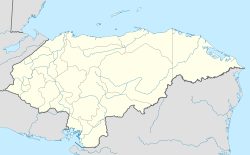Lejamaní facts for kids
Quick facts for kids
Lejamaní
|
|
|---|---|
|
Municipality
|
|
| Country | |
| Department | Comayagua |
| Area | |
| • Total | 22 km2 (8 sq mi) |
| Population
(2015)
|
|
| • Total | 5,781 |
| • Density | 263/km2 (681/sq mi) |
Lejamaní is a small and interesting place in Honduras. It is one of the 21 municipalities found in the Comayagua department. A municipality is like a local government area, similar to a county or a town. Lejamaní is located in the central part of Honduras.
Contents
History of Lejamaní
The story of Lejamaní goes back a long time. It started as a town in 1630. At that time, it was under the care of King Philip II of Spain. This means it was part of the Spanish colonial empire. Over the centuries, Lejamaní grew and developed. It became an official municipality in the department of Comayagua. This happened as Honduras gained its independence and formed its own government.
Geography and Location
Lejamaní is located in the Comayagua Department. This department is in the central region of Honduras. The municipality covers an area of about 22 square kilometers. That's roughly 8.5 square miles. Knowing its location helps us understand its climate and natural features. The coordinates for Lejamaní are 14°22' North latitude and 87°42' West longitude. These numbers help pinpoint its exact spot on a map of the world.
Population and People
As of 2015, the total population of Lejamaní was 5,781 people. This number tells us how many residents live in the municipality. The population density shows how many people live in each square kilometer. This helps us understand if an area is crowded or has a lot of open space. The people of Lejamaní contribute to the rich culture of Honduras. They often work in farming or other local industries.
What is a Municipality?
A municipality is a type of local government area. It usually includes a main town or city and the surrounding rural areas. In Honduras, municipalities are important for local administration. They help manage services like schools, roads, and public safety. Each municipality has its own local leaders. These leaders work to improve life for the people living there.
See also
 In Spanish: Lejamaní para niños
In Spanish: Lejamaní para niños


